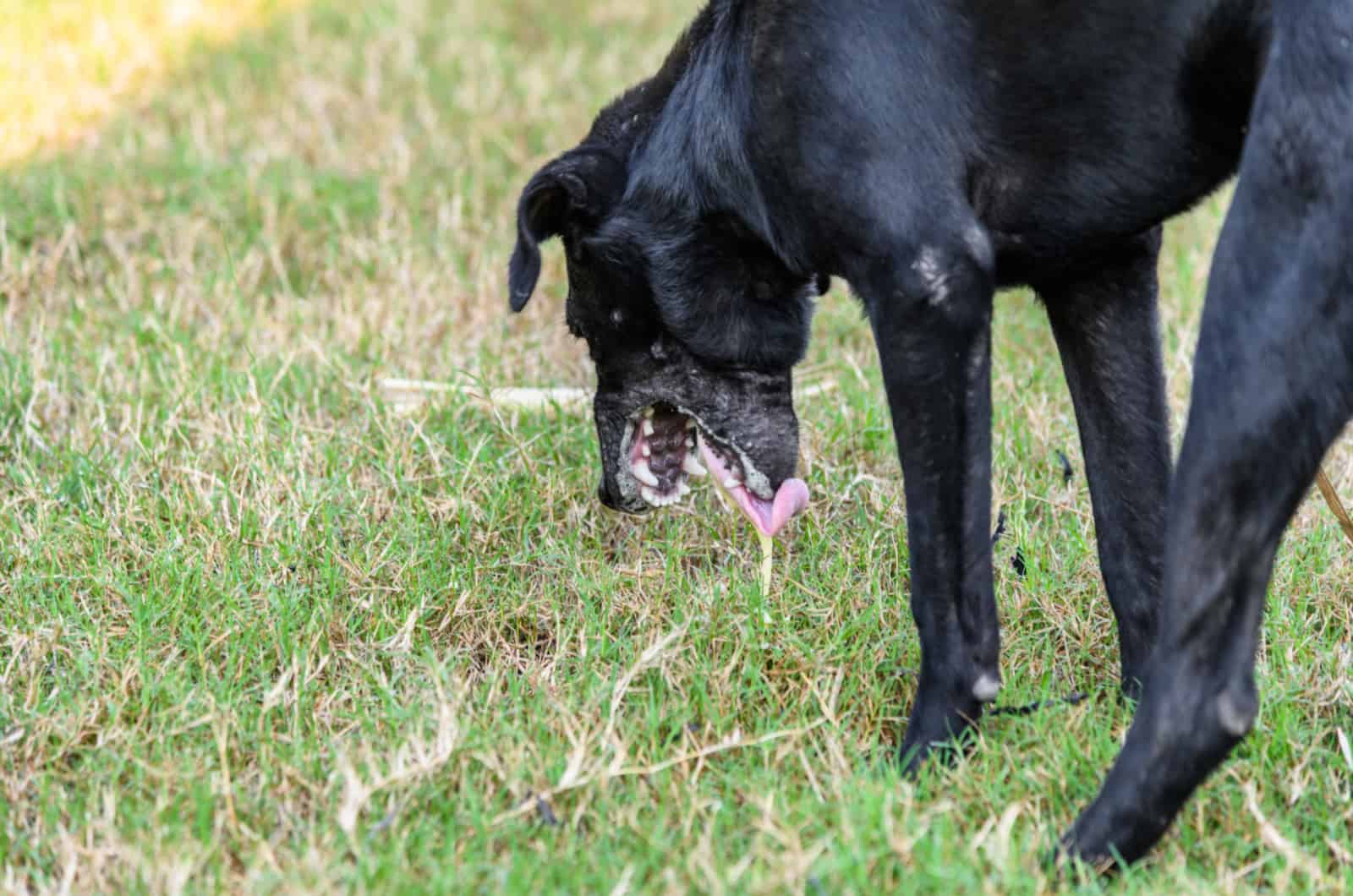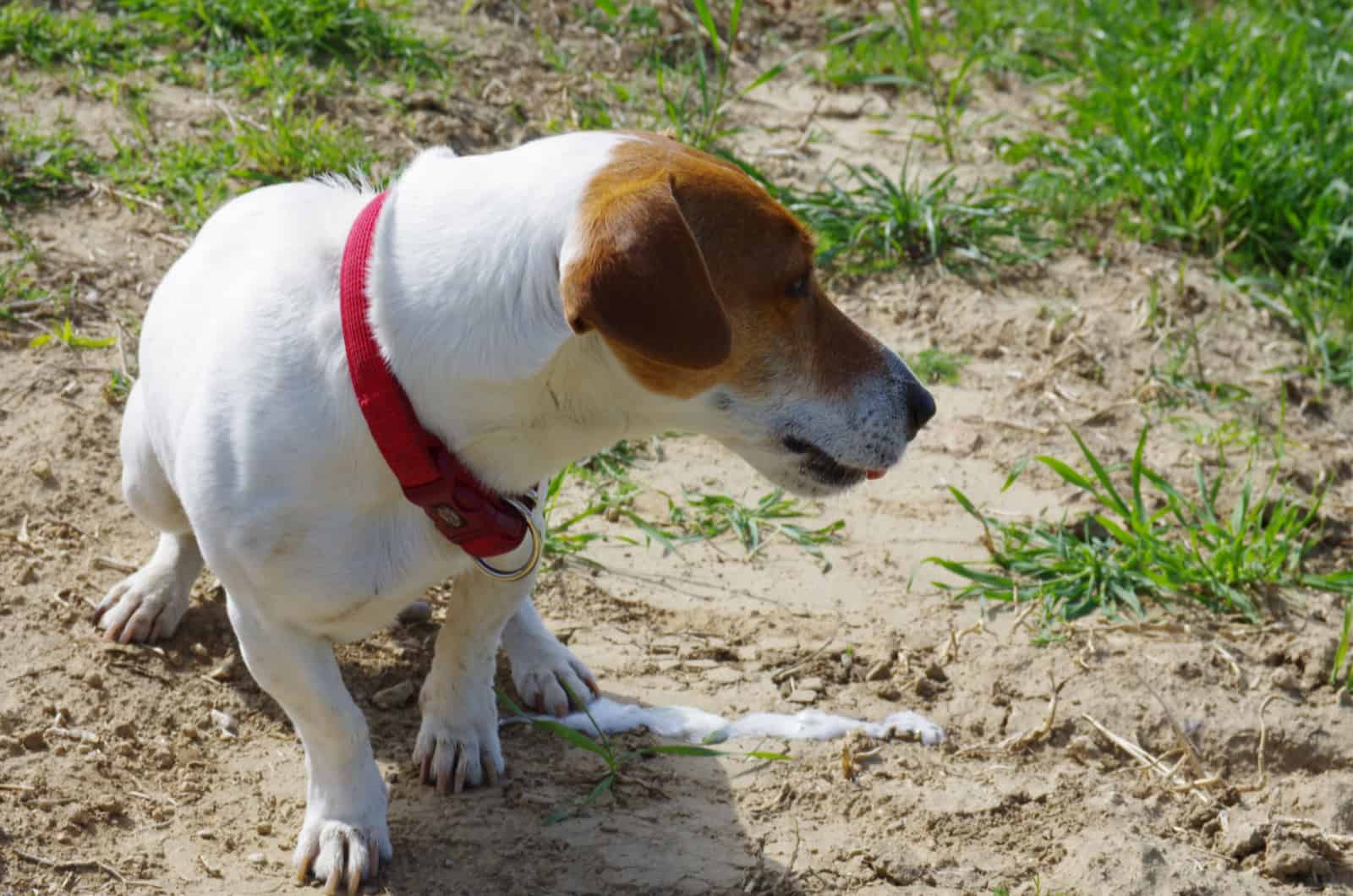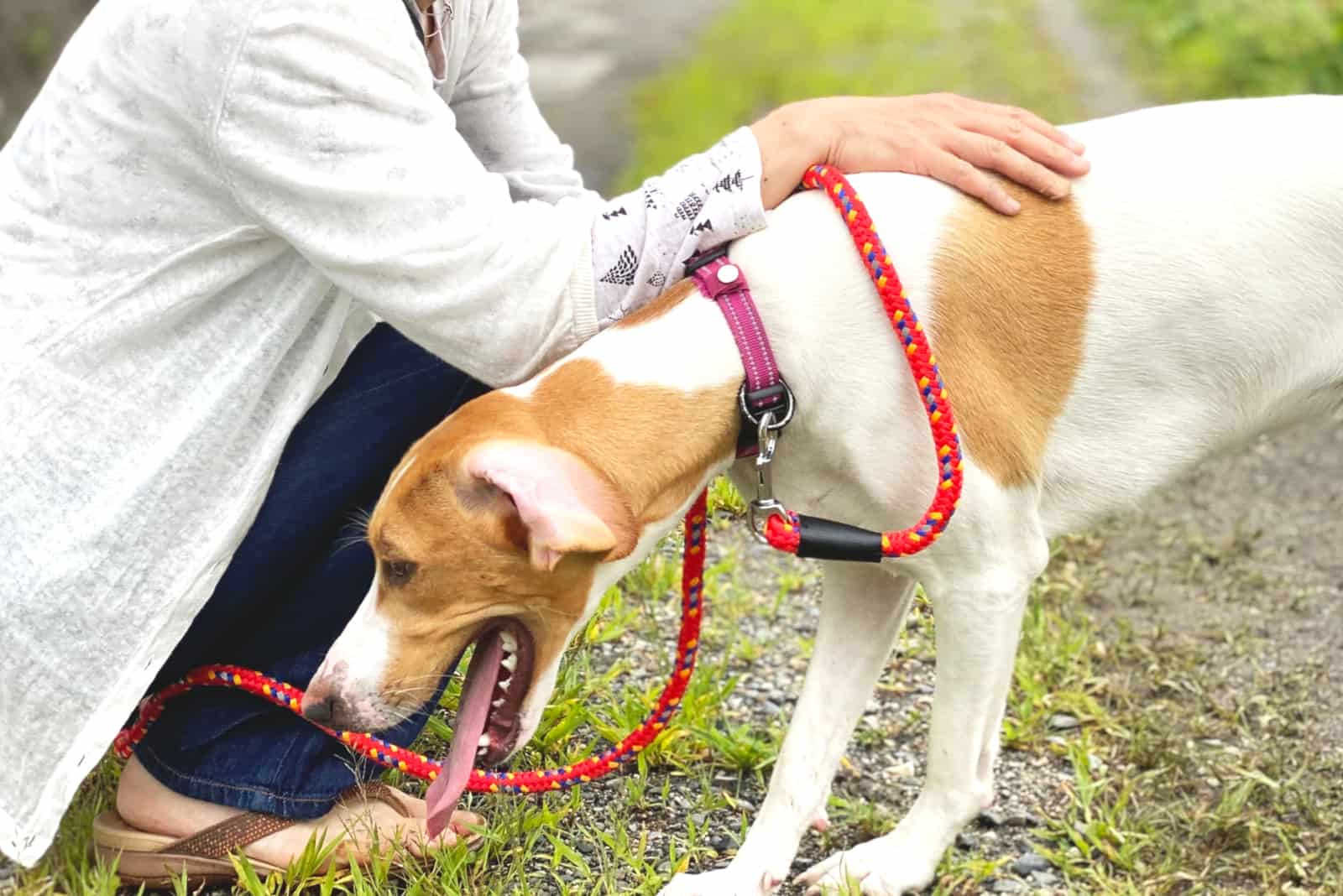Is my dog throwing up white foam because it ate something bad? Did my dog eat human food or maybe a foreign body? Or perhaps there is an underlying health issue to blame for its white foamy vomit? Is a dog throwing up white foam a life-threatening situation?
Help!
Whenever a dog vomits, these questions will arise in every dog owner’s head. A dog throwing up white foam is something no dog owner wishes to experience, but it occurs very often.
White foamy vomiting occurs when a dog eats something bad that makes its stomach upset.
However, a dog throwing up white foam can also be a red flag that there is underlying health issues. Vomiting of any kind might be a sign of a more serious health condition, particularly if it happens regularly.
Let’s find out why dogs vomit white foam and get to the bottom of this health issue.
Why Is My Dog Vomiting White Foam?

If you’re a pet owner, you probably know that dogs like to eat stuff that they shouldn’t. You will often find yourself stuffing your hands into your dog’s mouth to make it spit out whatever there is inside.
From eating grass, chicken bones, and random objects, to even eating poop—dogs really get a buzz out of it.
Naturally, an upset stomach in your dog is the direct result of something they just ingested.
Here are some of the many common causes to why a dog would throw up white foam:
• Eating grass
• Indigestion
• Foreign body ingestion
• Bloat
• Pancreatitis
• Parvovirus
• Kennel cough
• Kidney disease
• Bacterial infection
• Bilious vomiting syndrome
To distinguish what’s going on, dog owners should be aware of how their dog behaved prior to throwing up. Whether it ate something bad or went out to play with a full stomach.
What Could Be Causing My Dog To Throw Up White Foam?

Let’s begin by describing the least dangerous and then move up to some of the life-threatening conditions that may be linked to white foamy vomit in dogs.
To find out why your dog throws up white foam, we will break down each of these common causes one by one.
Eating Grass
It seems that grass is a delicacy for some dogs and we might never figure out exactly why dogs eat grass.
On one hand, eating plant material is good for your dog (because dogs are omnivores—they can eat plants). But, on the other hand, when your dog eats too much grass and similar plants with low nutritional value, this can lead to mild gastrointestinal problems.
Because, you know, too much of anything is not good.
So, when your dog eats too much grass, it throws up white foamy vomit, which is usually a one time thing. In other words, they don’t have vomiting episodes.
If you notice that your dog is eating grass, it might be a good idea to let your dog eat quality and nutritional greens, like cooked broccoli or brussels sprouts.
Quality fiber found in green veggies will help your dog poop healthy amounts of healthy feces. It will also aid in normal digestion.
Canine Indigestion
Indigestion is just a fancy way to say that your dog’s tummy is upset. Canine indigestion occurs because your dog eats a bunch of food that’s either low quality dog food, wrong human food, or it simply eats too much food.
So, canine indigestion is simply a matter of bad dietary habits. Now, this might not be the pet parent’s fault because a dog can find bad food by itself and proceed to eat it. Some dogs eat treats instead of dog food and quickly develop an uneasy feeling in their tummy.
Check out the most common signs of canine indigestion:
• Acid reflux is basically stomach acid going up the dog’s esophagus and getting out through its mouth, looking like white foamy vomit. Stomach acid buildup causes boat and abdominal pain in our beloved pooches, so their bodies relieve themselves through vomiting or pooping (often diarrhea).
• Nausea—often follows the acid reflux. Dogs with nausea often show signs of hypersalivation (overproduction of saliva) and panting. Hypersalivation is nothing more than a physiological mechanism that prevents potential tissue damage and it can be caused by harsh stomach acid.
In my canine patients, I have noticed that the most common cause of indigestion is when dogs have switched to a different dog food and also when they are given cold (straight out of the fridge), wet dog food.
Foreign Body Ingestion
Unlike other pets, dogs are very keen on ingesting foreign bodies. Our curious canines are always up to some silly business! They get their mouths on everything they find, including non-food stuff, like rubber bands, small balls, and hairpins. Let’s not forget to mention socks—dogs love socks!
All objects that are not digestible are labeled as foreign bodies. And, foreign body ingestion is very frequent in all dogs—especially young dogs.
If you catch your dog munching on underwear, immediately make it stop because you don’t want clothing items getting into your dog’s digestive system!
When a dog eats a foreign body, this can result in a minor health issue. However, ingesting a foreign body can also lead to a blockage in any part of the digestive tract. If there’s a foreign body stuck in the esophagus, your dog will cough, drool, and gag while trying to vomit.
If your dog eats a sharp foreign body, like a needle or a sharp piece of wood, this can lead to serious and even life-threatening health issues.
So, if you think that your dog has eaten a foreign body, take it to the vet. A professional DVM will run some X-rays to determine whether or not there’s a foreign body in your dog’s digestive system.
Kennel Cough
This is a respiratory infectious disease and it doesn’t have much to do with a dog’s digestive system. However, kennel cough affects your pet’s health by creating excess mucus in the upper respiratory system.
Dogs affected with this illness exhibit a honking goose-like cough that is so specific that most owners know straight away that it’s kennel cough flu.
This dry cough irritates the dog’s throat, which results in retching. In other words, a dog gags, but it doesn’t throw up. However, it can spit out white foamy liquid that resembles vomit.
Kidney disease
Canine kidney disease raises concern in dog owners because their puppy pees a lot, but it also throws up white foamy vomit.
As is the situation with most kidney diseases, a dog’s kidneys don’t function normally and the organism cannot clear itself from accumulated toxins. This leads to nausea, which results in vomiting.
Chronic kidney disease brings changes to your dog’s urine color, as well as frequent peeing, dehydration, lethargy, and weight loss.
Pancreatitis
Canine pancreas inflammation isn’t ascommon as kidney disease, but it does share the same symptom—throwing up white foam.
Due to the fact that the pancreas plays a big part in a dog’s digestive tract, its inflammation can cause irregular function of the dog’s digestive system.
More often than not, dogs with pancreatitis throw up white foam with parts of undigested dog food.
Canine Bloat (Gastric Dilatation Volvulus)
If your dog is bloated, it’s time to take it to the vet because this is a life-threatening health condition.
It’s easy to remember the main symptoms of canine bloat:
B—breathing problems
L—lethargy
O—overproduction of saliva (hypersalivation)
A—agitation
T—trying to vomit (dry heaving)
Bloat in dogs happens when their stomach fills up with food, gas, or liquid. However, this doesn’t mean that bloat will occur whenever your dog eats.
Bloat is always an acute condition that develops because of various reasons.
For example, when a dog eats large amounts of dog food very quickly and it tends to overstuff itself, which leads to stomach dilatation. Other factors, including genetic predisposition, anxiety, old age, and low quality dog food can lead to canine bloat.
When a dog’s stomach is bloated and he decides it’s time to go for exercise, the bloated tummy can twist and this will cause a blockage of blood flow to the stomach. A twisted tummy is called gastric dilatation.
Because of accumulated gas, fluid, and food inside its body, the dog will try to vomit and might need a helping hand.
So, don’t wait around. Help your bloated pooch by immediately seeking veterinary care!
Bacterial Infections
Bacterial infections in dogs can be very troublesome, especially for the digestive system. Besides the friendly bacteria that usually lives inside our dog’s tummy, there are bad bacterial colonies that can take over.
Consumption of contaminated food or water, suppressed immune system, secondary bacterial infections, overuse of antibiotics (microbial resistance) and other medication can lead to gastrointestinal inflammation.
This results in vomiting white foam, undigested food, diarrhea, and abdominal cramps.
Besides bacterial infection, severe Intestinal parasitic infestation can make your dog throw up white foam with a few worms!
Parvovirus
Parvovirus is an extremely dangerous viral infection that affects puppies and young dogs. It’s the deadliest among all of the health issues that we have previously mentioned.
Parvo is highly contagious and any pups that don’t receive their first set of vaccinations are prone to it. Parvovirus invades a puppy’s digestive system and literally destroys the intestinal tissues.
Having said that, it also causes awful diarrhea in puppies, especially at night. The putrid smell of this diarrhea is so specific that most vets instantly know it’s parvo.
Besides smelly and bloody diarrhea, puppies throw up white foam that can change to a yellow color. All of this causes severe dehydration and tissue damage.
Puppies with parvovirus can die within two days and it’s extremely important to seek veterinary care as soon as the first symptoms start to appear.
What Is The White Foam In My Dog’s Vomit?

Usually, some kind of irritant or trigger is what makes the vomit turn white and foamy. White foamy vomit looks like mucus with soap bubbles.
In dogs, white foamy vomit consists of:
• saliva
• excess air
• digestive fluids (stomach acid)
In contrast to yellow vomit, white foamy vomit is regurgitated. Regurgitation and vomiting are different.
When a dog regurgitates, it brings up the contents from the esophagus or undigested food from the stomach (straight after a meal).
However, vomiting is when dogs bring up digested food mixed with stomach acid. Vomit can be orange, yellow, or green-ish in color due to the bile present. Learn more in our dog vomit color chart.
Canine Bilious Vomiting Syndrome is another term that can be used to describe a condition where dogs throw up slimy yellow, orange, and green colored vomit.
What Can I Do To Help My Dog Stop Throwing Up White Foam?

In no situation should you just sit and wait for your dog to get better if it has been vomiting white foam. Your veterinarian is just a call away, so it’s best to ring them and ask whether or not you should bring your pooch to the clinic.
In the meantime, don’t offer your dog any food or water (for a maximum of twelve hours) until you are sure that the vomiting episodes have stopped.
After you have taken it to the vet, make a diet plan to ease your dog‘s stomach pain. You can boil chicken for your dog, along with rice and veggies (if he likes that).
As for young dogs and puppies, making puppy mush is a great idea because it will be easier on their stomach than dry kibble. You can mix bone broth with solid foods to get that mushy texture.
How Long Does It Take For A Dog To Get Better From Throwing Up White Foam?
All in all, your dog should feel better within 24 hours after vomiting.
Nonetheless, your dog’s recovery solely depends on what caused it to throw up white foam in the first place and how severe its condition was.
You see, canine indigestion doesn’t usually last for more than two days. However, if it takes longer, you should call your vet.
In case of upper respiratory infections and runny noses, it can take up to ten days for your vomiting dog to fully recover.
Final Thoughts
In a way, a dog throwing up white foam is a relatively frequent occurrence and it doesn’t always mean that there is a serious health issue.
If you’re an aspiring dog owner, keep in mind that you will most likely, at some point, discover your dog throwing up white foam. Try not to panic because panicking will do no good in situations like these. Instead, try to untangle the possible causes to why your dog has vomited in the first place.
Ask yourself “Did my dog eat something it shouldn’t have? Did my dog do too much physical activity after it had just eaten? Or, did the white foamy vomit appear out of nowhere?”.
These are some of the questions that your vet is going to ask you before running any health tests.
If your dog is having frequent vomiting episodes, and you notice that there is significant weight loss followed by a loss of appetite, you should immediately schedule a vet’s appointment.
Remember, putting your dog’s health first is necessary for it to live a long and happy life!
Related Content
How To Clean Diarrhea Out Of Carpet? No Mess In A Few Steps
Why Do Dogs Pant In The Car: 10 Causes & Solutions You Must Know
